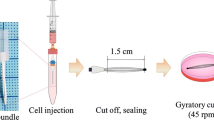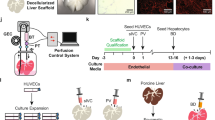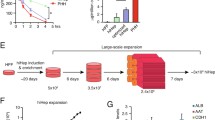Abstract
A hybrid bioartificial liver device supporting a large mass of cells expressing differentiated hepatocyte metabolic capabilities is necessary for the successful treatment of fulminant hepatic failure. The three-compartment gel-entrapment porcine hepatocyte bioartificial liver was designed to provide "bridge" support to transplantation or until native liver recovery is achieved for patients with acute liver failure. The device is an automated mammalian cell culture system supporting 6-7 × 109 porcine hepatocytes entrapped in a collagen matrix and inoculated into the capillary lumen spaces of two 100 kDa molecular mass cut-off hollow fiber bioreactors. Gel contraction recreates a small lumen space within the hollow fiber which allows for the delivery of a nutrient medium. This configuration supported hepatocyte viability and differentiated phenotype as measured by albumin synthesis, ureagenesis, oxygen consumption, and vital dye staining during both cell culture and ex vivo application. The hollow fiber membrane was also shown to isolate the cells from xenogenic immunoglobulin attack. The gel-entrapment bioartificial liver maintained a large mass of functional hepatocytes by providing a three-dimensional cell culture matrix, by delivering basal nutrients through lumen media perfusion, and by preventing rejection of the xenocytes. These features make this device a favorable candidate for the treatment of clinical fulminant hepatic failure.
Similar content being viewed by others
References
Arnaout WS, Moscioni AD, Barbour RI, Demetriou AA. Development of bioartificial liver: bilirubin conjugation in Gunn rats. J Surg Res. 1990;48:379–82.
Berry M, Edwards A, Barritt G. Assessment of integrity in isolated hepatocytes. In: Burdon R, van Knippenberg P, eds. Laboratory techniques in biochemistry and molecular biol-ogy. Isolated hepatocytes: Preparation, properties and applications. Amsterdam: Elsevier; 1991:83–98.
Demetriou AA, Rozga J, Podesta L et al. Early clinical experience with a hybrid bioartificial liver. Scand J Gastro-enterol Suppl. 1995;208:111–7.
Gerlach J, Encke J, Hole O, Muller C, Ryan C, Neuhaus P. Bioreactor for a larger scale hepatocyte in vitro perfusion. Transplantation. 1994;58:984–8.
Hager J, Carman R, Stoller R et al. A prototype for a hybrid artificial liver. Trans Am Soc Artif Intern Organs. 1978;24: 250–3.
Jauregui HO, Mullon CJ, Trenkler D et al. In vivo evaluation of a hollow fiber liver assist device. Hepatology. 1995;21:460–9.
Matsumura K, Guevara G, Huston H et al. Hybrid bioartificial liver in hepatic failure: preliminary clinical report. Surgery. 1987;101:99–103.
Miura Y, Akimoto T, Kanazawa X, Yagi K. Synthesis and secretion of protein by hepatocytes entrapped with calcium alginate. Artif Organs. 1986;10:460–5.
Neuzil DF, Rozga J, Moscioni AD et al. Use of a novel bioartificial liver in a patient with acute liver insufficiency. Surgery. 1993;113:340–3.
Nyberg S, Platt J, Shirabe K, Payne W, Cerra F. Immunopro-tection of xenocytes in a hollow fiber bioartificial liver. ASAIO J. 1992a;38:M463–7.
Nyberg S, Shatford R, Hu W, Payne W, Cerra F. Primary culture of rat hepatocytes entrapped in cylindrical collagen gels: an in vitro system with application to the bioartificial liver. Cytotechnology. 1992b;10:205.
Nyberg SL, Shatford RA, Hu WS, Payne WD, Cerra FB. Hepatocyte culture systems for artificial liver support: implications for critical care medicine (bioartificial liver support). Crit Care Med. 1992c;20:1157–68.
Nyberg S, Shatford R, Payne W, Hu W, Cerra F. Staining with fluorescein diacetate correlates with hepatocyte function. Biotechnic Histochem. 1993a;68:56–63.
Nyberg S, Shirabe K, Peshwa M et al. Extracorporeal applica-tion of a gel-entrapment, bioartificial liver: demonstration of drug metabolism and other biochemical functions. Cell Transplant. 1993b;2:441–52.
Nyberg SL, Mann HJ, Remmel RP, Hu WS, Cerra FB. Pharmacokinetic analysis verifies P450 function during in vitro and in vivo application of a bioartificial liver. ASAIO J. 1993c;39:M252–M256.
Platt J, LeBien T, Michael A. Interstitial mononuclear cell populations in renal graft rejection. J Exp Med. 1982;155: 17–30.
Platt J, Grant B, Eddy A, Michael A. Immune cell populations in cutaneous delayed-type hypersensitivity. J Exp Med. 1983;158:1227–42.
Rozga J, Holzman MD, Ro MS et al. Development of a hybrid bioartificial liver. Ann Surg. 1993a;217:502–9.
Rozga J, Williams F, Ro MS et al. Development of a bioartifi-cial liver: properties and function of a hollow-fiber module inoculated with liver cells. Hepatology. 1993b;17:258–65.
Rozga J, Podesta L, LePage E. A bioartificial liver to treat severe acute liver failure. Ann Surg. 1994;219:538.
Shatford R, Nyberg S, Payne W, Hu W, Cerra F. A hepatocyte bioreactor as a potential bioartificial liver: demonstration of prolonged tissue-specific functions. Surg Forum. 1992a;42: 54–6.
Shatford RA, Nyberg SL, Meier SJ et al. Hepatocyte function in a hollow fiber bioreactor: a potential bioartificial liver. J Surg Res. 1992b;53:549–57.
Sielaff T, Nyberg S, Hu M et al. Application of a novel bioartificial liver in a new model of canine fulminant hepatic failure. Surg Forum. 1993;75:63–5.
Sielaff TD, Hu MY, Amiot B et al. Gel-entrapment bioartificial liver therapy in galactosamine hepatitis. J Surg Res. 1995a;59:179–84.
Sielaff TD, Hu MY, Sridhar R et al. A technique for porcine hepatocyte harvest and description of differentiated meta-bolic functions in static culture. Transplantation. 1995b;59: 1459–63.
Sussman NL, Kelly JH. Artificial liver: a forthcoming attrac-tion. Hepatology. 1993;17:1163–4. } ai]Sussman NL, Gislason GT, Conlin CA, Kelly JH. The Hepatix extracorporeal liver assist device: initial clinical experience. Artif Organs. 1994;18:390–6.
Takahashi M, Ishikura H, Takahashi C et al. Immunologic considerations in the use of cultured porcine hepatocytes as a hybrid artificial liver. Anti-porcine hepatocyte human serum. ASAIO J. 1993;39:14.
Tompkins R, Carter E, Carlson J, Yarmush M. Enzymatic function of alginate immobilized rat hepatocytes. Biotech-nol Bioeng. 1988;31:11–8.
Uchino J, Tsuburaya T, Kumagai F et al. A hybrid bioartificial liver composed of multiplated hepatocyte monolayers. ASAIO Trans. 1988;34:972–7.
Yarmush M, Dunn J, Tompkins R. Assessment of artificial liver support technology. Cell Transplant. 1992;1:323–41
Author information
Authors and Affiliations
Rights and permissions
About this article
Cite this article
Sielaff, T., Nyberg, S., Rollins, M. et al. Characterization of the three-compartment gel-entrapment porcine hepatocyte bioartificial liver. Cell Biol Toxicol 13, 357–364 (1997). https://doi.org/10.1023/A:1007499727772
Issue Date:
DOI: https://doi.org/10.1023/A:1007499727772




